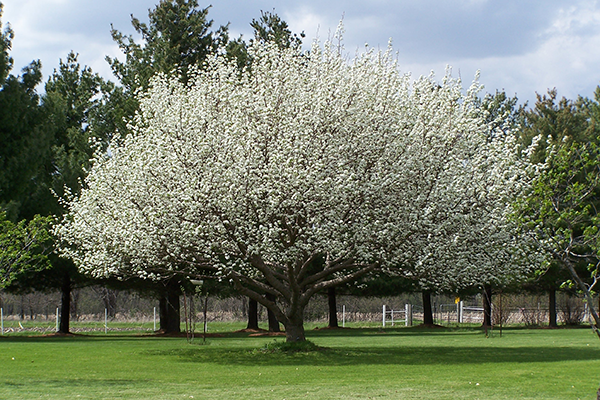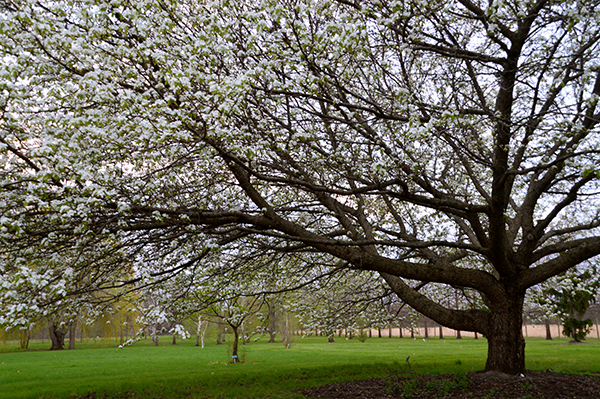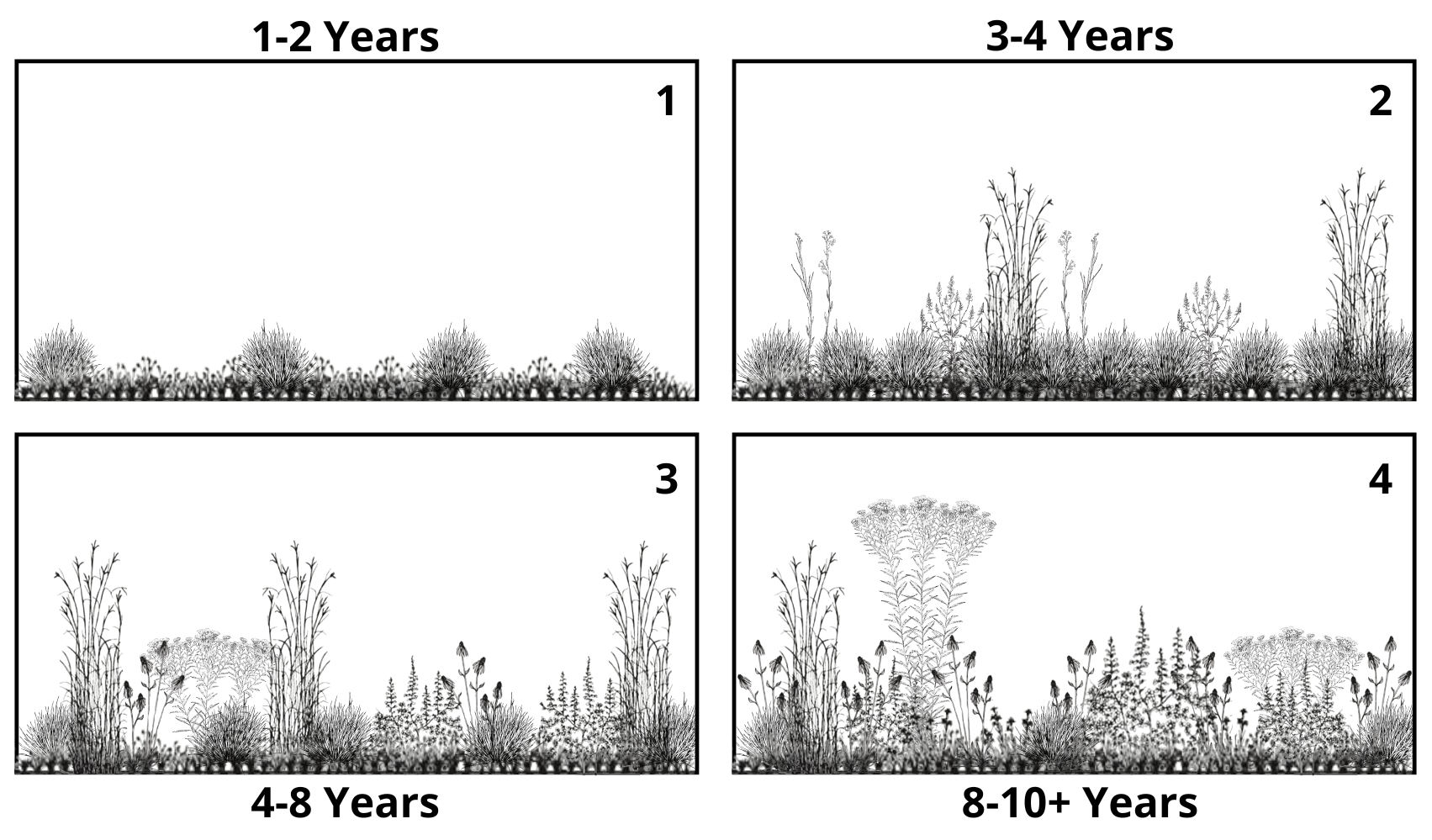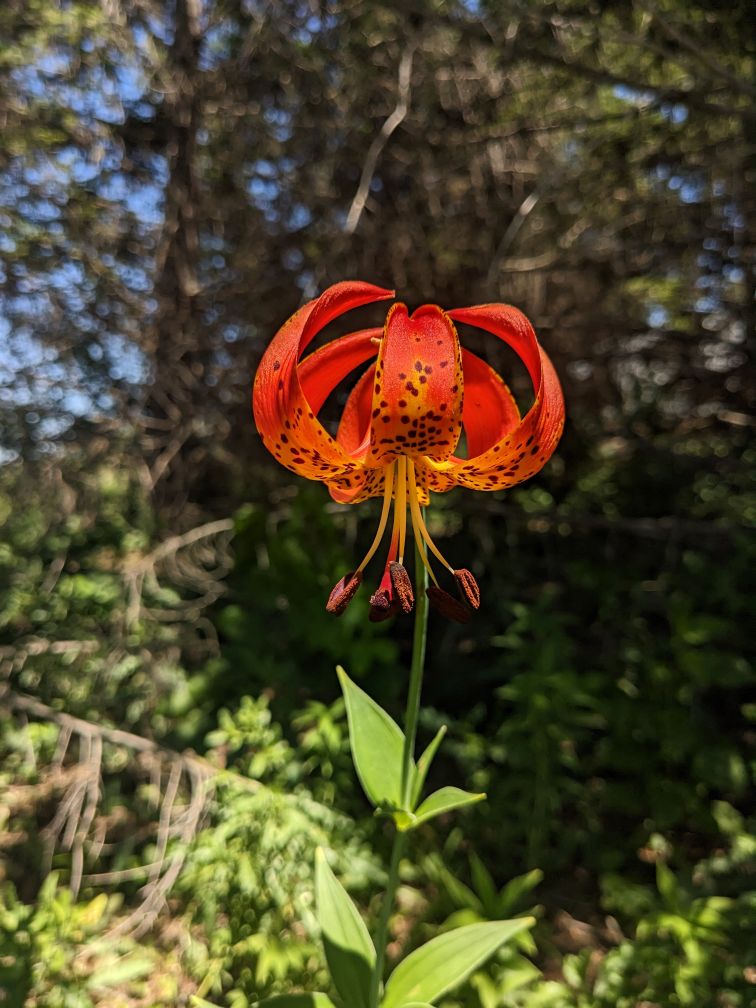FLOWERING TREE GROVE
A Grove in Transition
The flowering tree collection is one of the oldest collections on the arboretum’s grounds. Once full of dozens of magnolias, pears, crabapples, and redbuds, this grove was directly hit by the 2020 derecho. In order to preserve the trees still living and revitalize the north west corner of the arboretum, this grove area is undergoing a gradual transition into a meadow. Decades old crabapples are still dotted across the landscape and our honeybee hives are still located in this area. Behind this grove is a newly planted windbreak.
The Flowering Trees
Grown for their spectacular blooms, flowering trees are an important aspect of our gardens, city landscapes, and ecosystems. Often blooming early in the spring, they are the first abundant source of nectar for pollinators and a flash of color signaling warming temperatures. Many are fragrant, they are available in a rainbow of colors, and even some of our native flowering trees can be quite beautiful. During the summer months they provide shade and shelter becoming a favorite spot for birds to build their nests. Then the ripening fruit feeds migratory birds as they make their way south, and some fruit persists feeding our year-round feathered friends.

There are hundreds of options of flowering trees for home gardens. Some are dwarf, perfect for small spaces. Others grow into massive shade trees for shade and cooling the landscape. Some have even been bred to be sterile, lowering the mess that comes with fruit and preventing them from becoming weedy. Many flowering tree species are host plants for insects while also providing food for other wildlife. With all the varieties available on the market today, there is a flowering tree for every garden!

Successional Meadow
Only 65 years ago the west 40 acres of the arboretum was still covered in extensive woodlands. Logged and then tilled to farm, the property became a public garden soon after, leaving much of the underlying topography and seed bank in tact. In an effort to allow many of these native species to return, the arboretum stopped mowing the lawn around the flowering tree grove in 2023 to see what would happen.
This cessation of mowing is not unprecedented for the site. Even as late as 2014 this area was left to grow and hayed rather than regular mowing. Native plants that tolerate mowing have surged back, now growing big and beautiful with the new freedom of getting tall.
Over the next several years, this space will transform through series of succession. The first stage is the end of ecological disturbance activities, like mowing. It may not seem like much, but repeatedly mowing keeps competition to only species that can survive being mowed, the soil is compacted from repeatedly being driven over, and the mower blades pick up and distribute dust, soil, and plant seeds. This area also had extreme amounts of disturbance from the 2020 derecho and the cleanup activities afterward. The first plants to thrive are early successional species. The lawn itself, weedy plants, and annuals are the most common, taking advantage of open ground and recently disturbed soil. These plants rapidly grow to take over the area, stabilizing the structure of the soil, creating competition, and building stability of the new ecosystem. This is similar to what happens after a wildfire, flood, or tilling.
As the soil surface gets covered in vegetation and the soil profile stabilizes, perennial grasses and forbs are able to establish and grow. Even early on, young perennial plants that have tolerated being mowed suddenly have room to reach full size. New species may blow in from surrounding areas, or conditions may be right for new things to germinate from the seed bank. After about 3 years of no mowing, the species diversity and structure of the meadow begins to take shape.

By the third stage we will have to do some interventions. Undesirable or particularly aggressive perennial species may begin to spread faster than preferred, plant species we want may not have appeared on their own, and this is where the process of garden design can influence the final aesthetics of the meadow. Woody plant species like trees and shrubs will begin to show up, and they will have to be managed to keep the characteristics of an open meadow. Competition for light and space will have started to eliminate the lawn and the soil will be packed with vegetation, so annuals will have a hard time growing. Species that we want to add will have to be planted as large plants, and will be designed in a pleasing way that still provides the feeling of a natural space.
Long-term management of this garden involves disturbing the soil as little as possible. While traditionally this type of landscape would be burned, it will instead by mulch-mowed once a year while the ground is frozen. This eliminates most disturbance while building organic matter and contributing desirable seeds to the seed bank. Most plants will be native and cultivars of native species, reminiscent of a clearing in the woods or florally abundant prairies.
Other No-Mow Benefits
The added benefits of not mowing include less fuel cost and consumption, decreasing emissions and pollution. Mowing our vast lawn spaces regularly is a big sink on time, labor, and resources that can be used instead to make areas beautiful! Mowing also deters wildlife from visiting gardens, and can be distracting while trying to enjoy beautiful landscapes. Finally, mowing can cause serious damage to tree roots, including wounding shallow root systems causing stress and creating openings for disease. As the arboretum’s collection grows, we will continue to reduce the amount of lawn we mow on a regular basis.
Observations
As we continue to watch the progress of the successional meadow, staff have been cataloguing observed desirable species to help inform the future plant palette of this meadow. Over the years, we hope the species diversity continues to expand while becoming ever more beautiful. Observations so far are listed below:
Andropogon gerardii – Big bluestem
Astragalus canadensis – Canadian milkvetch
Carex grisea – Wood gray sedge
Koeleria macrantha – June grass
Lilium michiganense – Michigan lily
Prunella vulgaris – Self-heal
Pseudognaphalium obtusifolium – Sweet everlasting
Symphyotrichum pilosum – Frost aster
Viola sororia – Common blue violet

Back to Our Plants hompage
Plant List:
Acer saccharinum ‘Commemoration’ – Commemoration sugar maple
Carya ovata – Shagbark hickory
Magnolia stellata ‘Jane Platt’ – Jane Platt star magnolia
Malus x ‘Adams’ – Adams crabapple
Malus x ‘Kibele’ – Kibele crabapple
Malus x ‘Leola’ – Leola crabapple
Malus x ‘Margo’ – Margo crabapple
Malus x ‘Pink Spires’ – Pink spires crabapple
Malus x ‘Professor Sprenger’ – Professor Sprenger crabapple
Malus x ‘Robinson’ – Robinson crabapple
Malus x ‘Sugar Tyme’ – Sugar tyme crabapple
Malus x ‘Van Eseltine’ – Van Eseltine crabapple
Picea glauca – White spruce
